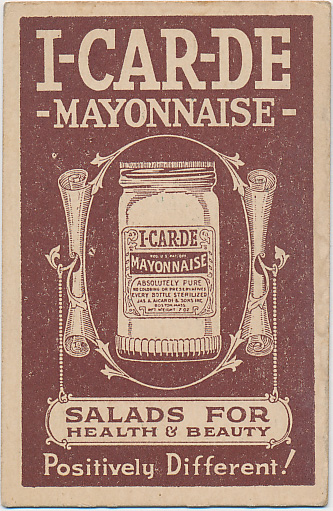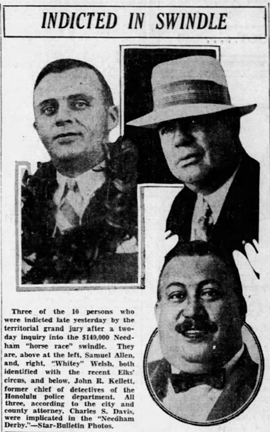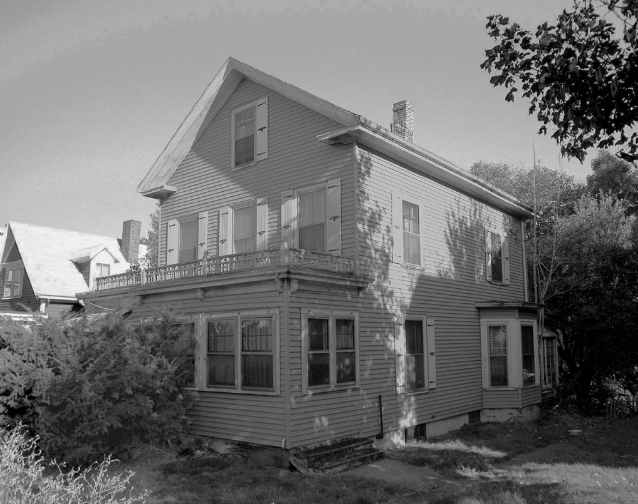James Augustus Aicardi and Beatrice Marie Aicardi
World War Veterans
By Camille Arbogast
Siblings James Augustus and Beatrice Marie Aicardi were born at 285 Broadway in South Boston. Beatrice was born on July 2, 1893, and James on October 10, 1896. Their parents, Giacomo, known as James, and Angelina (Guinasso) Aicardi, were both born in Italy. Angelina immigrated to Boston when she was about a year old. Originally from Porto Maurizio in Liguria, James, Sr. came to the United States in the early 1880s, when he was about 15 years old. He initially settled in Brockton, Massachusetts. James, Sr. and Angelina were married in Boston in 1886. They had four other children: Frank born in 1887, Catherine in 1892, Leonard in 1898, and a second Catherine in 1901. Leonard died at 7 months of pneumonia; the first Catherine also died of pneumonia at age 2.
In the 1890s, the family lived at 285 Broadway in South Boston, where James, Sr. had a fruit store. By 1902, the Aicardis resided around the corner at 164 ½ Silver Street, though James, Sr.’s store remained at 285 Broadway. That year, older brother Frank ran away because his parents were upset with his “smoking cigarettes and reading cheap novels every spare moment.” He made it as far as Woonsocket, Rhode Island, where he was spotted by a police officer. He eventually returned home, because in 1905 Frank was fined $10 for “playing dice on the Lord’s day.” James and Beatrice attended school in South Boston, James graduating from the Lincoln School in 1904 and Beatrice from the Norcross School in 1907.
In 1913, James, Sr. and Angelina founded the Aicardi Food Products Company. I-Car-De Mayonnaise, their signature product, was advertised as “positively different!” Their factory was located at 93 Stoughton Street in Dorchester. In 1915, the Aicardis moved to Dorchester, and lived at 124 Adams Street.

During the First World War, both Beatrice and James served in the military. Beatrice was a female Yeoman in the US Naval Reserve Force. Called “Yeomanettes,” female Yeomen were officially enrolled in the Navy and received the same rate of pay as men. The Naval Act of 1916 included a line permitting the enlistment of “all persons who may be capable of performing special useful service for coastal defense.” The non-gendered language was interpreted to include women, and they were recruited beginning in March 1917. By the end of the war there were over 11,000 female Yeomen. They most often served in clerical roles, though some held specialized positions. Beatrice enrolled in the Navy at the Boston Enrolling Office on June 4, 1918. She served in the Boston Navy Yard (today known as the Charlestown Navy Yard) from August 28, 1918, until the Armistice on November 11, 1918. She probably lived at home during her service, as the Navy did not have female barracks and women had to make their own living arrangements. Generally, they were assigned work in their home communities. Beatrice was included in a group photograph, “Panorama of Yeowomen before Drill,” taken at the Boston Navy Yard on December 16, 1918. The women wore long dark skirts, dark single-breasted jackets, and brimmed hats, the attire specified by the Navy for Yeowomen. There was no officially-issued female uniform, and the women were responsible for acquiring the required items themselves. Beatrice was placed on inactive duty on June 26, 1919, and discharged on June 4, 1920.
At the time of the second draft in June 1918, James was working for the United States Quartermaster Department, at Warehouse G, on Commonwealth Pier in Boston. He was inducted into the Army on August 17, 1918, and initially served in Company 13, 4th Training Battalion, 151st Depot Brigade. In October 1918, he was transferred to the Cantonment Headquarters Detachment. He was made a Corporal on December 5. James was discharged from Camp Devens in Ayer, Massachusetts, on March 14, 1919.
On October 10, 1920, James married Bertha V. Batts, a brush factory worker. They were married by Father William B. Whalen of St. Monica’s Church on Dorchester Street in South Boston. The couple had three children: Bertha born in 1921, James in 1926, and Donald in 1928. Initially, James and Bertha lived with his parents, who, by 1920, were living at 66 Romsey Street. In 1923, James and Bertha moved to 3 Pearl Street, then the next year to 15 Sumner Street. James worked for the family business.
In 1923, James, Sr. and Angelina moved to 91 Stoughton Street, where they remained until 1927, when they returned to South Boston, purchasing 1726 Columbia Road. In 1927, Beatrice married Thomas F. Keating. Thomas, who had also grown up in South Boston, was a salesman at a wholesale leather company and a World War I veteran. Later, Thomas was active in Boston politics. In July 1927, James, Sr. died. In 1930, Beatrice and Thomas were living at 1726 Columbia Road. Angelina, the owner of the building, lived in another unit. James and his family were next door at number 1724.
James died on December 19, 1936. According to an article in the Boston Globe, an employee found him on the floor of his office. The family physician pronounced him dead, telling reporters that James suffered from heart attacks and had probably died of one. A solemn high mass of requiem was celebrated for him at South Boston’s Gate of Heaven Church and he was buried in Calvary Cemetery in Roslindale. He was given full military honors at his funeral.
In 1940, Beatrice, Thomas, and Angelia still lived at 1726 Columbia Road. It appears the I-Car-De mayonnaise factory closed in 1944. By 1954, Beatrice and Thomas were listed in the Boston Directory living at 1728 Columbia Road. Angelina died in 1956. In the early 1960s, Beatrice and Thomas moved to an apartment at 1800 Columbia Road. Thomas died in 1981.
Beatrice died on January 18, 1984. Her funeral mass was held at St. Brigid Church in South Boston.
Sources
Birth, marriage, death records: Massachusetts Vital Records, 1840–1911. New England Historic Genealogical Society; Ancestry.com.
Naturalization Records. National Archives at Boston, Waltham, Massachusetts; Ancestry.com
Boston directory, various years; Ancestry.com
Family trees; Ancestry.com
1900, 1910, 1930, 1940 United States Federal Census; Ancestry.com
“Frank Aicardi Missing,” Boston Post, 6 May 1902:2; Newspapers.com
“Frank Aicardi Missing,” Boston Globe, 20 May 1902: 14; Newspapers.com.
“South Boston,” Boston Globe, 9 Nov 1905: 20; Newspapers.com
Annual Report of the School Committee of the City of Boston 1904, Boston: Municipal Printing Office, 1904: 210; Archive.org
Documents of the School Committee of the City of Boston for the Year 1907. Boston: Municipal Printing Office, 1907: 71; Archive.org
Taylor, Earl. “Dorchester Illustration 2263 I-CAR-DE Mayonnaise,” Dorchester Historical Society blog, 21 August 2016; DorchesterHistoricalSociety.org
Military, Compiled Service Records. World War I. Carded Records. Records of the Military Division of the Adjutant General’s Office, Massachusetts National Guard.
“World War I era Yeomen (F),” Naval History and Heritage Command,
<https://www.history.navy.mil/our-collections/photography/people—special-topics/women-in-the-navy/world-war-i-era-yeomen–f–.html>
Patch, Nathaniel. “The Story of the Female Yeomen during the First World War,” Prologue Magazine, Fall 2006, Vol. 38, No. 3, The U.S. National Archives and Records Administration,
<https://www.archives.gov/publications/prologue/2006/fall/yeoman-f.html>
“World War I Yeowomen at the Charlestown Navy Yard,” National Park Service Boston, US Department of the Interior, last updated 12 June 2017; NPS.gov
World War I Selective Service System Draft Registration Cards, 1917-1918. Washington, D.C.: National Archives and Records Administration; Ancestry.com
Marriage Record, “Massachusetts State Vital Records, 1841-1920,” Massachusetts State Archives; FamilySearch.org
Department of Public Health, Registry of Vital Records and Statistics. Massachusetts Vital Records Index to Marriages [1916–1970]. Boston, MA: New England Historic Genealogical Society, Boston, Massachusetts; Ancestry.com
“James A. Aicardi Sr of South Boston Dead,” Boston Globe, 22 July 1927: 3; Newspapers.com
“James Aicardi Dies Suddenly,” Boston Globe, 19 December 1936: 2; Newspapers.com
“Military Funeral For James Aicardi,” Boston Globe, 22 Dec 1936: 7; Newspapers.com
“Mrs. Angelina Aicardi,” Boston Globe, 8 March 1956: 13; Newspapers.com
“Thomas Keating, 83,” Boston Globe, 1 December 1981: 24; Newspapers.com
Death notices, Boston Globe, 21 Jan 1984: 31; Newspapers.com


